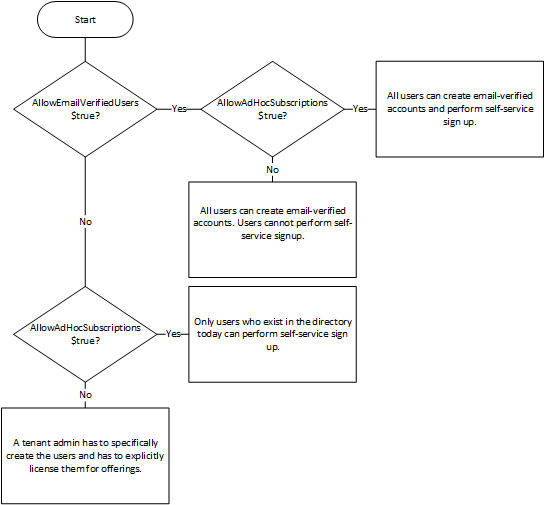What is self-service sign-up for Microsoft Entra ID?
This article explains how to use self-service sign-up to populate an organization in Microsoft Entra ID, part of Microsoft Entra. If you want to take over a domain name from an unmanaged Microsoft Entra organization, see Take over an unmanaged tenant as administrator.
Why use self-service sign-up?
- Get customers to services they want faster
- Create email-based offers for a service
- Create email-based sign-up flows that quickly allow users to create identities using their easy-to-remember work email aliases
- A self-service-created Microsoft Entra tenant can be turned into a managed tenant that can be used for other services
Terms and definitions
- Self-service sign-up: This is the method by which a user signs up for a cloud service and has an identity automatically created for them in Microsoft Entra ID based on their email domain.
- Unmanaged Microsoft Entra tenant: This is the tenant where that identity is created. An unmanaged tenant is a tenant that has no global administrator.
- Email-verified user: This is a type of user account in Microsoft Entra ID. A user who has an identity created automatically after signing up for a self-service offer is known as an email-verified user. An email-verified user is a regular member of a tenant tagged with creationmethod=EmailVerified.
How do I control self-service settings?
Admins have two self-service controls today. They can control whether:
- Users can join the tenant via email
- Users can license themselves for applications and services
How can I control these capabilities?
An admin can configure these capabilities using the following Microsoft Entra cmdlet Set-MsolCompanySettings parameters:
- AllowEmailVerifiedUsers controls whether users can join the tenant by email validation. To join, the user must have an email address in a domain that matches one of the verified domains in the tenant. This setting is applied company-wide for all domains in the tenant. If you set that parameter to $false, no email-verified user can join the tenant.
- AllowAdHocSubscriptions controls the ability for users to perform self-service sign-up. If you set that parameter to $false, no user can perform self-service sign-up.
AllowEmailVerifiedUsers and AllowAdHocSubscriptions are tenant-wide settings that can be applied to a managed or unmanaged tenant. Here's an example where:
- You administer a tenant with a verified domain such as contoso.com
- You use B2B collaboration from a different tenant to invite a user that doesn't already exist (userdoesnotexist@contoso.com) in the home tenant of contoso.com
- The home tenant has the AllowEmailVerifiedUsers turned on
If the preceding conditions are true, then a member user is created in the home tenant, and a B2B guest user is created in the inviting tenant.
Note
Office 365 for Education users, are currently the only ones who are added to existing managed tenants even when this toggle is enabled
For more information on Flow and Power Apps trial sign-ups, see the following articles:
How do the controls work together?
These two parameters can be used in conjunction to define more precise control over self-service sign-up. For example, the following command allows users to perform self-service sign-up, but only if those users already have an account in Microsoft Entra ID (in other words, users who would need an email-verified account to be created first can't perform self-service sign-up):
Import-Module Microsoft.Graph.Identity.SignIns
connect-MgGraph -Scopes "Policy.ReadWrite.Authorization"
$param = @{
allowedToSignUpEmailBasedSubscriptions=$true
allowEmailVerifiedUsersToJoinOrganization=$false
}
Update-MgPolicyAuthorizationPolicy -BodyParameter $param
The following flowchart explains the different combinations for these parameters and the resulting conditions for the tenant and self-service sign-up.

This setting's details may be retrieved using the PowerShell cmdlet Get-MsolCompanyInformation. For more information on this, see Get-MsolCompanyInformation.
Get-MgPolicyAuthorizationPolicy | Select-Object AllowedToSignUpEmailBasedSubscriptions, AllowEmailVerifiedUsersToJoinOrganization
For more information and examples of how to use these parameters, see Update-MgPolicyAuthorizationPolicy.
Next steps
Feedback
Coming soon: Throughout 2024 we will be phasing out GitHub Issues as the feedback mechanism for content and replacing it with a new feedback system. For more information see: https://aka.ms/ContentUserFeedback.
Submit and view feedback for